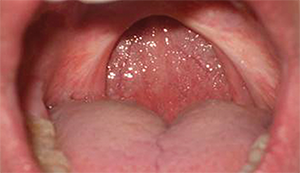Options abound for addressing the hypopharynx in patients who have obstructive sleep apnea (OSA); however, choosing an approach is not always straightforward.
Explore This Issue
March 2017Panelists involved in a session focused on hypopharyngeal collapse reviewed some of the ins and outs of traditional surgery, upper airway stimulation, and transoral robotic surgery (TORS).
Traditional Surgical Procedures
Jimmy Brown, DDS, MD, professor of otolaryngology-head and neck surgery at Augusta University in Georgia, said the abundance of surgical options—genioglossus advancement, hyoid suspension, and hyoid myotomy among them—does not necessarily translate to optimal results. “The surgical options are numerous, and usually that’s the case when none of them works really well,” he said.

Patient following a uvulopalatopharyngoplasty.
© wikipedia
Genial tubercle advancement (GTA) is still considered the “standard” for dealing with hypopharyngeal collapse but is sometimes thought to be associated with a high complication rate, Dr. Brown said. The numbers actually don’t bear that out, with studies showing a 0.3% to 2% complication rate, he said. “If you look at the early series, the complication rates were pretty small and probably should not deter us as otolaryngologists to incorporate that procedure into our armamentarium,” he added.
Comparing Outcomes
When outcomes for hypopharyngeal procedures are compared, though, there is no clear winner. The majority of studies are level 4 (evidence-based medicine) and are case series. Looking at a systematic review of eight studies comprising 151 patients, GTA in combination with uvulopalatopharyngoplasty (UPPP) had a success rate of 61%. For hyoid suspension with UPPP, a review of five studies comprising 123 patients had a success rate of 71%. For tongue suspension with UPPP, a review of eight studies (167 patients) had a success rate of 62%.
“They all pretty much have the same outcomes,” Dr. Brown said, acknowledging that these were not high-powered studies.
Additional research has found that better outcomes are more common for stand-alone hyoid procedures when compared with stand-alone base-of-tongue procedures, with rates of 56% and 36% respectively (Laryngoscope. 2014;124:329–336; Otolaryngol Head Neck Surg. 2011;144:225–229).
“If you have to do one thing or the other, maybe securing the hyoid would be more efficacious,” said Dr. Brown. “Stabilizing the hyoid impacts all the collapsible walls of the hypopharynx, while stabilizing the tongue only primarily impacts the anterior wall of the hypopharynx.”
Upper Airway Stimulation
M. Boyd Gillespie, MD, MSc, chair of otolaryngology at the University of Tennessee in Memphis and a member of the ENTtoday editorial advisory board, gave an update on upper airway stimulation, an approach that is becoming more popular for treating patients intolerant to continuous positive airway pressure (CPAP).